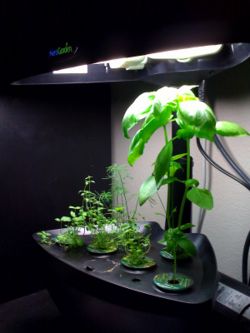Food/Controlled Environment Agriculture
 , show that hydroponics yields represent an increase on normal growing techniques of about 50% to over 1700%. The precision of control over the growing medium also lends itself to automation more readily than does growing in soil. And — best of all — by optimizing the nutrient flow, we can supply plants with the nutrients they need to produce the flavonoids that give them their flavour. With controlled growing, it is possible to achieve a more intense flavour than growing in soil.
, show that hydroponics yields represent an increase on normal growing techniques of about 50% to over 1700%. The precision of control over the growing medium also lends itself to automation more readily than does growing in soil. And — best of all — by optimizing the nutrient flow, we can supply plants with the nutrients they need to produce the flavonoids that give them their flavour. With controlled growing, it is possible to achieve a more intense flavour than growing in soil.
Hydroponics also achieves a ten- or twenty-fold decrease in the amount of water compared to growing in soil [1]. Aeroponics is an even more water-efficient method of growing plants, where the roots are suspended in a dark box and occasionally misted with controlled sprays of nutrient-enriched mist. Aeroponics pioneer Richard Stoner has claimed that aeroponics uses 2% the water of drip irrigation. Aeroponics also results in significantly higher yields than hydroponics [2].
LEDs can be used as an alternative to the sun in providing the light for plants to grow. Unlike ordinary lightbulbs, LED panels can be designed to emit a full spectrum of light, which is what plants need to grow. LEDs could be useful in situations where sunlight is unavailable - such as in winter in regions far from the Equator, in underground or underwater dwellings, in cities where a demand for space means food must be grown on stacked shelves indoors, and in space stations. Currently the main obstacle to large-scale controlled environment agriculture projects such as The Vertical Farm Project is the cost of energy needed to provide the light. As LEDs become cheaper and more energy-efficient (as with recent developments in OLED and PHOLED technology) this sort of production of high-quality food is becomes more and more feasible.Light use can also be optimized by using fibre-optic cables to pipe sunlight down from the rooftop to the plants. This would significantly reduce the amount of energy needed.
Using aeroponics and LED grow lights, the conditions of plant-growth can be precisely monitored, controlled and optimized. A controlled environment greatly reduces the threat of pests and plant-diseases, and allows for fast, consistent growth of healthy, nutritious, pesticide-free and tasty plants. Also, controlled environments eliminate the dependence of food production upon the cycles of the season, allowing food to be grown all year around. This fact effects at least a fourfold increase in productivity over traditional farms. Dickson Despommier, an advocate of vertical, controlled-environment farming, has painted a picture of what this farming might be like -
"Each floor will have its own watering and nutrient monitoring systems. There will be sensors for every single plant that tracks how much and what kinds of nutrients the plant has absorbed. You'll even have systems to monitor plant diseases by employing DNA chip technologies that detect the presence of plant pathogens by simply sampling the air and using snippets from various viral and bacterial infections. It's very easy to do.
Moreover, a gas chromatograph will tell us when to pick the plant by analyzing which flavenoids the produce contains. These flavenoids are what gives the food the flavors you're so fond of, particularly for more aromatic produce like tomatoes and peppers. These are all right-off-the-shelf technologies. The ability to construct a vertical farm exists now. We don't have to make anything new."
Aeroponic plant production is the most advanced method of growing food available. It lends itself easily to automation, while at the same time minimizing water, energy and land use, maximizing nutritional values and producing awesome food. It is commercially viable now, even in our scarcity-based economy, and there are several profitable aeroponic farms. As these scale-up, it will become more and more cost-effective. The Vietnamese government is introducing a large-scale scheme to grow potatoes aeroponically.


